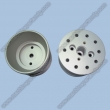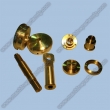# Stainless steels are an iron alloy comprised of 10.5 to 30 percent chromium. Stainless steel gets its stainless attribute from the chromium-rich oxide that forms an invisible and adherent external film. Nickel, molybdenum, copper, titanium, aluminum, silicon, niobium, nitrogen, sulfur, and selenium also improve the quality of the stainless steel.
Corrosion (Oxidation) Resistance
# Stainless steel shows excellent resistance among the materials that withstand corrosion in several environments. This is due to a phenomenon called passivity, in which the surface layer on the steel repairs itself. Additional chromium increases corrosion and oxidation resistance. Further, nickel (Ni) broadens the range of conditions that stainless steels can deal with. Additions of molybdenum (Mo) and nitrogen (N) improve pitting and crevice corrosion resistance. Copper also increases corrosion resistance in hazardous environments where sulfuric acid is used.
Mechanical and Physical Properties
# Alloy additions increase basic mechanical strength. Mechanical and physical properties (toughness, strength and ductility), ease of fabrication (specifically ease of forming) tremendous fatigue resistance and energy absorption capacity are some of the traits of stainless steel. These qualities guarantee the suitability of the material produced, and engineers use these traits to compute the safety of working loads or pressures.
Forming, Fabrication & Joining Techniques
# Stainless steels are formable and machinable based on their type and heat-treated condition. Stainless steels can also be manipulated by casting or forging. Nearly all types and grades of stainless steels can be joined by soldering, brazing and welding. Allowing for their strength and work hardening characteristics, most types of stainless steel can be machined by traditional methods. Welding enhances most stainless steels' joint strength and corrosion resistance.
Uses of Stainless Steel
Stainless steel uses are nearly limitless. In the home, stainless steels are used in the production of dishware and other cutlery, dinner service, pots and cooking utensils, kitchen sinks, stoves and outdoor barbeques, and gardening tools and furnishings. In the cities and towns, stainless steel is used in building facades, bus shelters, lifts and escalators, phone booths and other street fixtures, and subway cars and station equipment. In industry, stainless steel uses include making tools for the creating of pharmaceuticals and food products, industrial plants for the management of drinkable and waste water, chemical and petrochemical plants, automotive and aero plane engine parts, and petroleum and chemical tankers.







